Audio Transcription Technology
AUDIO
TRANSCRIPTION

The aim of this assignment is to outline key areas for Audio Transcription. Audio Transcription, in its simplest form it is the transformation of verbal and audio materials onto a text document. The typist has the use of Headphones to hear the recording and uses a foot pedal to control the speed and stop/play of the audio and also rewind and fast forward. The typist has to record the audio as they hear it and follow any instructions given by the speaker.
There is a lot of reference material which can be used to ensure accuracy when doing audio transcription. Below is a description of some:
Spell Checker: This is used to check the accuracy of the spelling of an electronic document with the use of a software program that compares words in the document with a list of acceptable spellings. You can also permanently put a new word into the dictionary if it’s not already there so spell check won’t continuously show it up as incorrect spelling.
Thesaurus: Is a reference work that lists words grouped together according to similarity of meaning (containing synonyms and sometimes antonyms), in contract to a dictionary, which provides definitions for words, and generally lists them in alphabetical order. The main purpose of such reference works is to help the user “to find the word, or words, by which an idea may be most fitly and aptly expressed” – to quote Peter Mark Roget, architect of the best known thesaurus in the English language.
Mims: MIMS or monthly Index of Medical Specialities is an independently edited publication designed as a prescribing guide for the general practitioner. It is aimed at healthcare professionals, including general practitioners (GPs), pharmacists, nurses and secondary care specialists. It is considered dangerous practice to refer to old editions. Concise drug monographs form the core of MIMS; these include key safety information (contraindications, warnings, interactions and adverse effects) and details of the active ingredient, presentations, price, indication, dosage and manufacturer. Entries are independently compiled by the MIMS editorial team based on the full Summary of Product clinical guidance. The MIMS website features a predictive search function that allows users to search the drug listings by brand, generic ingredient or drug class. Online versions of the comparison tables and guideline summaries are supplemented by additional web only resources including clinical calculators and patient fact sheets. Al the content is freely available except the drug listings. Registrations is free for GPs but other users much subscribe.
It is very important to ensure accuracy is met at all times when doing Audio Transcription. You are dealing with sensitive information and also you run the risk of e.g. putting the wrong medicine name on a prescription or wrong information on the doctors notes which can have catastrophic results.
The main screen of the Olympus Dictation Management System Software which is used for Audio Transcription is shown below:

This is the changing of the Layout of the Page/document that is being used through the Page Layout on the Toolbar. There are many ways to change the Layout and here is a breakdown of a few.
Page Layout:To change the Orientation (direction) of the Page/Document, click on the Page Layout icon on the top left hand side of the Toolbar.


From there click on Orientation with your mouse
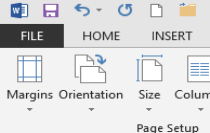


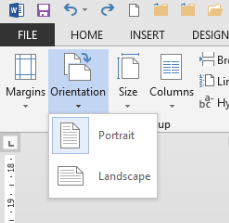
Portraitor Landscape will appear then click on the icon that is required and it will change.
SPACING:To change the spacing (bigger or smaller) between each line, click into Page Layout on the top right hand corner of the toolbar.


The spacing column is in the centre of the Page.

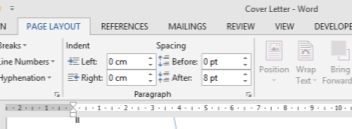
The spacing can now be adjusted between each line of the wording.
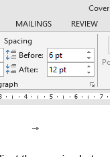
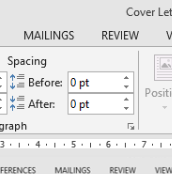



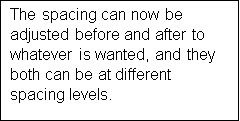
FONT:Changing the Font type and size by manually going into the top right hand side of your toolbar and clicking on the drop down arrow beside the Font style, scroll down the list and click on the chosen one. This can be done for both Font Type and Size. The shortcut to this is to right click on the mouse and the same toolbar options pop up and the same actions can be completed.


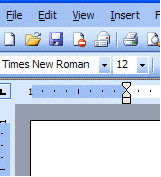
BOLD:Changing the font to bold, click on the B on the top right hand corner of the Toolbar by clicking on the B or the shortcut to it is Ctrl and B. Ensure to unclick the letter B on the Toolbar menu or re-click the shortcut Ctrl and B or it will keep writing with Bold.

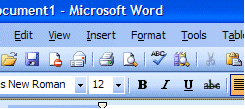
ITALICS:Changing the font to Italics, this can be accessed on the top right hand corner of the toolbar by clicking on the Ior the shortcut to this is Ctrl and the letter I. Ensure to unclick the letter Ion the toolbar or re-click the shortcut Ctrl and I or it will keep writing in Italic’s.


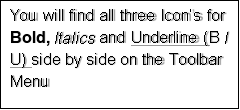
|
Shannon Medical Centre |
Memo
|
To: |
Melinda McCarthy |
|
From: |
Yvonne Wesley |
|
Cc: |
Alexandra Hughes |
|
Date: |
January 13, 2017 |
|
Re: |
Andrew Williams |
Personal
Please organise the chest x-ray for the above lady at your earliest convenience.
You might copy Margaret in on the outcome.
The basic business letter format is the same across a range of industries, with few variations for content and style. The letter should be left-aligned, single-spaced with a one-inch margin and a standard 11-or 12-point type size. The top line below the letterhead should be the correct date, followed by one line of space followed by Our Ref space and Your Ref (if relevant) and the address of the recipient. Following this Urgent/For attentions of in bold (if relevant). Place one line of space after the recipient’s address and use a simple, professional greeting and another line of space. Each following paragraph should be separated by a line. Insert one line after the last paragraph, followed by a closing. Leave four lines of space for your signature, and type your name and title. It is important do either use Full Punctuation or Open Punctuation.
Ennis Hospital,
Ennis,
Co Clare.
18 July 2017
Our Ref: VR/CR
Dr Raefel Jones,
St John’s Hospital,
Alberton Road,
Dublin 4.
Re: Mrs Helen Brindsley DOB 02/10/65 – 2 The Maltings, Ennis, Co Clare.
Dear Dr Raefel,
This lady was admitted to this hospital on 29th June last for investigation of early dementia. As you know she is vague and disorientated and an abnormal behaviour pattern has been noted both at work and by her family. There were no abnormal signs on examination. The investigations arranged showed normal Vitamin B12 metabolism but the results of thyroid function studies are meaningless in view of previous therapy with Tabs Thyroxine.
The most significant finding was some cortical atrophy demonstrated by an air encephalogram. The cerebrospinal fluid examined at the time of the radiological procedure showed a raised protein content of 74 mg per 100 million; there were no cells in the fluid and the sugar content was normal.
I think the dementia is the pre-senile variety and I fear the condition will deteriorate. I have interviewed her husband and made him aware of the prognosis but no doubt you will be seeing him to discuss the matter further and to give him all possible support.
Yours sincerely,
__________________________
Viictor Radetski FRCP DPM
Consultant Psychiatrist
It is very important to give special attention when dictating numerical figures and units of measurements. A minor change in numerical values or units of measurements can harm the patient.
It’s important that dictated numbers are easily understood by the transcriptionist. The teen numbers can be confused with “ty2 numbers, as in 13/30, 14/40, 15/50, 16/60, 17/70, 18/80 and 19/90. For example, when you dictate 14, say “Fourteen, that’s one, four”, or 50, say “Fifty, that’s five, zero.[T1]
- Full stops, colons, question marks, dashes, semi colons and exclamation marks are usually dictated.
- The start of a new paragraph is indicated by the word “paragraph”.
- Words to be underscored are dictated and then followed by the instructions ‘underscore’; e.g., ‘Please send me details of your personal (underscore personal) computers.’
- Initial capitals are not usually indicated, but if there is a doubt, the following method is used: ‘initial capital/initial capitals’ e.g., ‘I have a current account with the (initial capital) National Irish Bank.’
- The 24-hour clock is dictated as spoken; e.g., ‘thirteen hundred hours (typed without a full stop) 1300 hours.
- If you are using open punctuation, there are no full stops in abbreviations. Even with full punctuation, certain abbreviations do not have full stops. If for some particular reason the dictator wants stops inserted, he would say, ‘capital letters N stop U stop R stop’ N.U.R.
Bullets are normally used when ranking and order are not important and will not be referenced later. For example:
- Application Form
- Proof of address
Numbering is usually used when you need to reference them. For example:
All applicants must provide the following documents:
a) Application form
b) Proof of address
Item b) can be any utility bills, bank statements or letters from government agencies.
And if ranking or order (e.g. steps to bake a cake) is important, then it makes sense to use numbering.
You can access the Bullet/Numbering key on the Toolbar on the main screen of your Microsoft Word document as show below.


Tables are used to lay out information in individual columns and rows within a Word Document. The point where the column intersects with the row is known as a cell. To create a table first click onto the Toolbar menu at the top of the page, click on Insert. Below is an example of when at table can be used in Audio Transcription
|
Medical Term |
Meaning |
|
|
1 |
Blood Pressure (BP) |
The pressure of the blood in the Circulatory System |
|
2 |
Complete Blood Count (CBC) |
A blood test used to evaluate overall health and detect any health issues |
|
3 |
Lung disease characterized by chronic obstruction of lung airflow that interferes with normal breathing and is not fully reversible |
|
|
4 |
Deep venous thrombosis (DVT) |
Blood clot in large vein |
|
5 |
Fracture (FX) |
Complete or incomplete break in a bone resulting from the application of excessive force |
|
6 |
Pulse (P) |
The rhythmic dilation of an artery that results from beating of the heart |
|
7 |
Rebound (REB) |
Rebound tenderness of the abdomen when pushed in and then released. |
|
8 |
Three times daily (TID) |
As in taking medicine three times daily |
|
9 |
Upper Respiratory Infection (URI) |
Any number of viral or bacterial infection |
|
10 |
Vital Signs are stable (VSS) |
From the standpoint of the temperature, blood pressure, and pulse, the patient is doing well. |
To create a table first click onto the Toolbar menu at the top of the page, click on Insert.

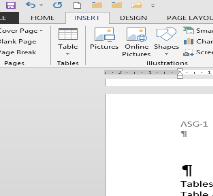
Next Click on Tables.

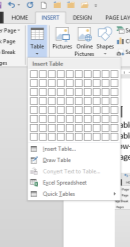 i
i
Pull the mouse over the box and it will show up as many columns as needed, when there is enough of the box highlighted just click on the left hand side of the mouse and it will insert a table as below.
Now all data can be filled into each column or row as required.
Columns are used in a Word Document to change the layout of the page into sections or columns across the page. This is beneficial if you want to save space on a page and fit more text in. To set up the columns you go to the page Layout on the Screen and click into it.


Click into columns

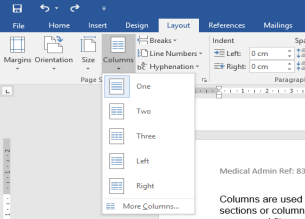
From here select as many columns as you need.
|
Medical Term |
Meaning |
|
|
1 |
Blood Pressure (BP) |
The pressure of the blood in the Circulatory System |
|
2 |
Complete Blood Count (CBC) |
A blood test used to evaluate overall health and detect any health issues |
|
3 |
Lung disease characterized by chronic obstruction of lung airflow that interferes with normal breathing and is not fully reversible |
|
|
4 |
Deep venous thrombosis (DVT) |
Blood clot in large vein |
|
5 |
Fracture (FX) |
Complete or incomplete break in a bone resulting from the application of excessive force |
|
6 |
Pulse (P) |
The rhythmic dilation of an artery that results from beating of the heart |
|
7 |
Rebound (REB) |
Rebound tenderness of the abdomen when pushed in and then released. |
|
8 |
Three times daily (TID) |
As in taking medicine three times daily |
|
9 |
Upper Respiratory Infection (URI) |
Any number of viral or bacterial infection |
|
10 |
Vital Signs are stable (VSS) |
From the standpoint of the temperature, blood pressure, and pulse, the patient is doing well. |
[i] http://www.nthdegreeservices.co.uk/audio-transcription-in-newcastle.html
[ii] https://en.wikipedia.org/wiki/Monthly_Index_of_Medical_Specialities
[iii] https://en.wikipedia.org/wiki/Thesaurus
[iv] https://www.2ascribe.com/articles/dictation-tips/dictating-numbers-and-dates
[v] http://ell.stackexchange.com/questions/16246/in-formal-writing-when-to-use-bullets-and-when-the-numbers
[vi] http://www.medicinenet.com/list_of_common_medical_abbreviations_and_terminology-page6/views.htm
[T0]The spacing in this letter is too big – keep example on one page
[T1]This is irrelevant – you are writing about the transcriptionist
[T2]This is not about word processing – you need to describe what tables and columns might be used for in audio transcription